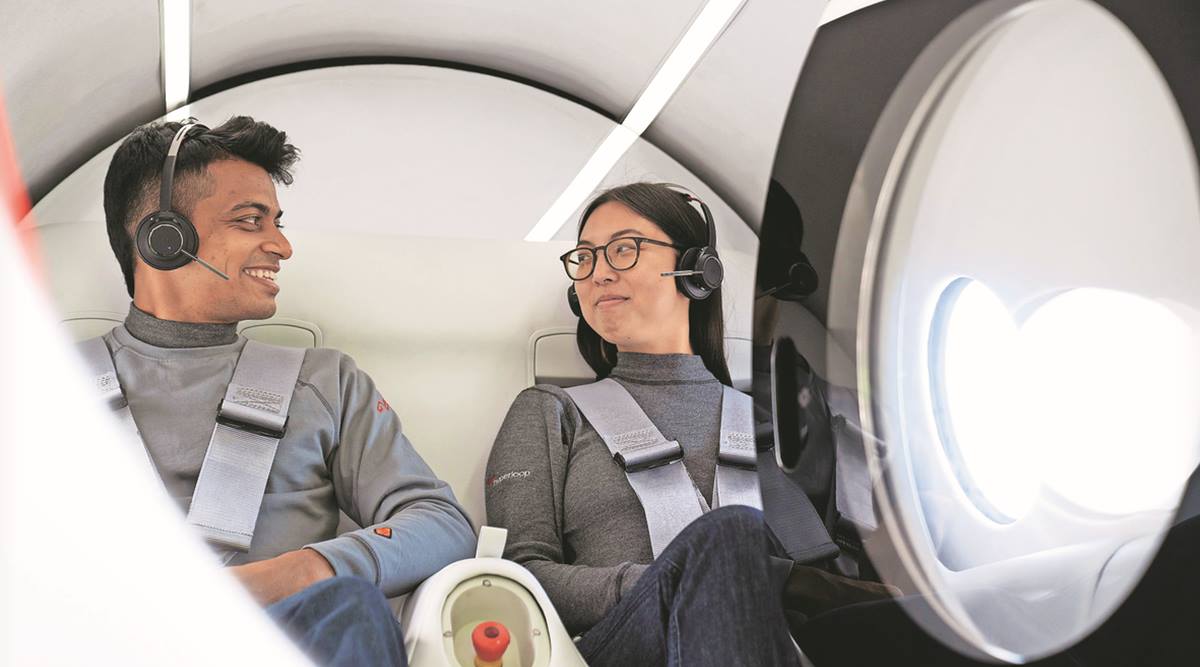
“We don’t care about speed … We don’t sell speed, we sell time.”
This may seem surprising coming from the co-founder of the American firm Virgin Hyperloop. Yet Josh Giegel, now one of the first people in the world to take on the transportation system involving levitating test capsules traveling at high speeds, knows what he’s talking about.
“If Hyperloop was moving at a million kilometers per hour, but had to stop at all places, or had to wait two hours to go up, that’s not that effective, right?” explains Giegel, who was part of the test conducted by the company last month. “So, it’s the whole experience: how long is the wait, going straight to the destination and things like that. We bring all the benefits of airplane speed with the convenience of the rail experience, without having to wait, and at the same time reducing energy use. “
Another passenger in the first set of tests conducted by Virgin Hyperloop, which Giegel first envisioned six years ago, was Tanay Manjrekar. Originally from Pune, Manjrekar is a power electronics specialist who has been with the company since 2016. “I was going to try to get into the pod any way I could,” says Manjrekar. “I have always dreamed of creating a hyperloop, but riding on it was beyond dreams. When that opportunity presents itself, it would have been stupid not to take advantage of it. “
Hyperloop, a new form of transportation currently being developed by a number of companies, envisions passengers traveling at high speeds in floating capsules housed within giant low-pressure tubes, either above or below ground. The system is not used commercially anywhere in the world and Virgin Hyperloop is still testing in the US.
Last month, NITI Aayog formed a panel to study the Hyperloop in depth, including member VK Saraswat, the Chairman of the Board of Railways, and the Secretaries of Housing and Urban Affairs, Road Transport and Highways. The panel will draw on the experience of Delhi Metro and IIT, among others. On Saturday, the Chairman of the Board of Railways, VK Yadav, said: “Hyperloop is a technology that is still evolving around the world. The government is looking at it as a transportation technology, that’s all I can say right now. “
As part of the first leg in India, Virgin Hyperloop plans to connect Pune and Mumbai, covering the distance of 150 km at speeds of 1200 km / h in about 35 minutes, one-tenth of the time it currently takes on the road. Giegel says this is just the beginning and that at least 7,000 km of hyperloop is possible in India.
 Josh Giegel says it’s just the beginning and that at least 7,000km of hyperloop is possible in India.
Josh Giegel says it’s just the beginning and that at least 7,000km of hyperloop is possible in India.
Virgin Hyperloop has also signed a memorandum of understanding to conduct a feasibility test regarding a link between Bengaluru city center and Kempegowda International Airport, and is working with the Punjab government for a corridor between Amritsar and Chandigarh. .
While the technology hurdle has more or less been overcome, an uphill task is convincing regulators of something like that again. “We all try to connect something new with what we already know. So people look at the Hyperloop and think, it’s obviously not a car, and it’s definitely not an airplane, and it’s not really a ship, so it must be a train, ”Giegel explains in his frustrations.
But the talks have been progressing. “In July, the US Department of Transportation provided us with regulatory guidance. In fact, they said that we are an official means of transport, which is very important. India, as part of the Mumbai to Pune project, also declared us an infrastructure project. “In Europe, Hyperloop has been included as part of the Smart Mobility strategy.
Giegel believes that it is important to have these conversations in parallel. “If we wait until everything is perfect, certification will take too long,” he says, adding that recent testing focused a lot on “incremental development of technology and incremental development of security.” Regulators, he says, were very excited about the way the testing was done and the rigor of the process.
The lack of sleep for the past few months is finally paying off. “We didn’t think it would happen so quickly.”
The tests were only able to reach 172 km / h, but Giegel says that is because the Nevada test track was only 500 meters long. “The goal was not speed, it was safety,” he says, adding that a new certification track being built in West Virginia will allow glimpses of higher speeds.
Manjrekar doesn’t see many challenges in the hyperloop to get where it should, and if there are bumps, he believes the company has strong design practices and technology to overcome them. “In terms of challenges, it’s really a race for governments right now to get the first one,” he adds.
Giegel intervenes: “We have shown that it is possible to travel safely with this, not by astronauts but by normal people. I think the most important thing for me is how fast we can climb. “
With ENS tickets
.